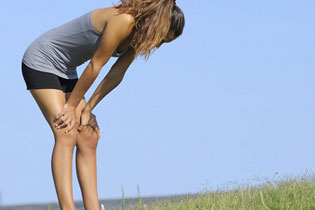Exercise-induced asthma
What is exercise-induced asthma?
— Exercise-induced asthma is when a person with asthma has breathing problems during or after exercise. Doctors often call it “exercise-induced bronchoconstriction” instead. That’s because exercise does not actually cause asthma. But it can trigger symptoms in some people who already have asthma.
What are the symptoms of exercise-induced asthma?
— Symptoms can include:
- Coughing
- A tight feeling in the chest
- Shortness of breath
- Wheezing (hearing a whistling sound when you breathe)
Symptoms happen when the airways in the lungs become narrow and inflamed. In people with exercise-induced asthma, this usually happens about 10 to 15 minutes after starting to exercise. In most cases, the symptoms go away after about 1 hour.
These symptoms are different from shortness of breath that happens during an asthma “attack” or flare-up. A person having an asthma flare-up might have more trouble breathing if he or she tries to exercise. That’s because the airways are already narrowed.
Is there a test for exercise-induced asthma?
— Yes. But if you already know you have asthma, you might not need testing. Your doctor might be able to tell that you have exercise-induced asthma based on your symptoms. Or, your doctor might have you do a breathing test, such as:
- An “exercise challenge test” – This involves using a treadmill or exercise bike for several minutes, then doing a breathing test. The test shows your doctor how your lungs are working. A similar test involves inhaling a special mixture of dry air while breathing fast, like you would if you were exercising.
- A test that involves breathing in a special medicine – For this, you do a breathing test before and after inhaling the medicine. If you have asthma, the medicine will cause your airways to narrow.
Your doctor might also check for other problems that can cause similar symptoms. For example, people with vocal cord narrowing, lung disease, and some heart problems can have trouble breathing after exercising.
How is exercise-induced asthma treated?
— If you get exercise-induced asthma, you can treat it with a “quick-relief” medicine. The medicines used for this are short-acting beta agonists (called “SABAs” or “short-acting bronchodilators”). Examples of SABAs are Salbutamol (Ventolin) and Terbutaline (Brincanyl).
Your doctor or nurse will tell you how and when to use your inhaler. Most people need 2 puffs to relieve symptoms. If you keep having symptoms, you can take 2 puffs again after 20 minutes. If you get exercise-induced asthma, make sure you have your “quick-relief” inhaler with you anytime you plan to exercise.
Some people feel shaky after taking a SABA. If this happens, talk to your doctor or nurse. He or she might switch you to a different medicine or lower your dose.
Can exercise-induced asthma be prevented?
— Yes. First, it’s important to take all your asthma medicines the way your doctor or nurse tells you to. Keeping your asthma controlled can lower the chances of having symptoms when you exercise.
You can also:
- Take medicine before you exercise – This usually involves using your “quick-relief” inhaler 5 to 15 minutes before exercising, to help prevent symptoms. SABAs are the medicines most often used to prevent exercise-induced asthma. But some people, such as children who are physically active many times a day, get another type of asthma medicine instead.
If you exercise most days of the week and need your “quick-relief” medicine each time, your doctor might suggest an asthma controller medicine if you don’t already take one. This is a medicine you take every day, even when you are not having symptoms. This way you won’t need the “quick-relief” medicine as often.
- Avoid exercising in certain conditions – Very cold, dry air can make symptoms worse. If you do exercise outside on a very cold day, it might help to wear a loose scarf or mask over your nose and mouth. It can also help to avoid exercising in polluted air, or around pollen or mold if you are allergic.
- Warm up before you exercise – Some people find that a warm-up period helps prevent exercise-induced asthma. But this isn’t true for everyone.
You should not avoid exercise completely in order to prevent exercise-induced asthma. Exercise is important for staying healthy. Plus, regular exercise and better fitness can actually help reduce asthma symptoms. Your doctor and nurse can help you figure out what kind of exercise is best for you, and how to prevent and treat symptoms.

